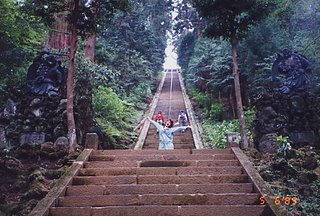 Photo of Saiji Temple by Ikumi Kishiya
Photo of Saiji Temple by Ikumi KishiyaTokyo,Japan
It was one of those hot, humidious Japanese July days. The air didn't move and Tokyo became the citymost closely resembling a giant sauna. The Japanese population had peaked at 130 million souls back in 2020; many of the young being of mixed Japanese and foreign blood. The face of Japan had changed due to the high number of international marriages in the early part of the 21st century and the continuing prevalence of mixed marriages. With so many Japanese going abroad to do business and so many foreigners coming to Japan to do the same, romance naturally followed. As Japanese improved their English, communicationwas no longer an issue, and 50 hour a week salarymen were not as attractive to long suffering Japanese women anymore. Some still went the traditional route and married the boy or girl next door, while others married their partners from Malaysia, Canada, China, France, Brazil and Nigeria to name but a few. Japan had become a country of "beige babies," as they were fondly dubbed by the press, as had much of the world. America and Canada had been moving in thatdirection for sometime and Japan was no longer as isolated as it had been in the days before Admiral Perry's "Black Ship."
This change wasn't a conscious decision, like so many issues in Japan, the government didn't do anything toact on it. "It just kind of happened," an ailing, 80 year old former Prime Minister Mori had stated in an AsahiShimbun interview. With zero growth in population, and dwindling domestic consumption, Japanese were forced to send most of their factories abroad to take advantage of cheaper labour and other costs.For the first time, Japan placed in the top ten for clean air in the world. Toyota had led the way with hybrid cars in thelate 20th century and now all cars were either solar, hydrogen or nuclear powered. A safe form of nuclear propulsion had been invented in 2017, and slowly these cars were coming online. Tokyo was no longer so smoggy.Few could imagine these great changes in the early part of the 21st century, but then again in 1919, who could haveimagined the coming to power of Adolf Hitler? Who could have imagined another world war right after World War 1?Who could have imagined the popularity of SMAP? Often huge changes are difficult to imagine, and makeone uncomfortable to think about.
With the huge increase in foreign born Japanese and children of mixed race, Japan was forced to join much of the world andenact laws preventing racial discrimination. Banning foreigners from bathouses in Otaru and banning Koreans born in Japan from joining golf clubs in Chiba had become a thing of the past. References to late Tokyo Governor Ishihara were reminders of a bureaucratically, racist past. Ishihara was no longer held in such high esteem as he had been in the earlypart of the century. He was now regarded as a political dinosaur and racist ideas like his were shouted down in theJapanese Diet, if they were even heard at all.
It was in this atmosphere that Sylvie Tanaka became Miss World. The mixed race Japanese people were some of themost beautiful in the world and Sylvie was no exception. She was smart, trilingual, and understood Asian and Western culture. Due to many protests, the Miss World Pageant had become much more dependant upon how one presented oneself. You had to be a good speaker. You had to have something to say. You had to be well educated. Certainly beauty helped, and Sylvie was gorgeous, but her speech entitled "Beige is Beautiful," was one of the most talked about of the year. The time was ripe for Sylvie's speech.
Finally, many of the tenets of the major religions were consistently being realized. People were mixing more, and what was in your heart became more important than the colour of your skin or the country of your ancestors. Religion started to do what it was supposed to do, bring people closer together and help to bring heaven on earth.Much of the latest research pointed to a reality far greater and richer than we had ever imagined. Einstein's theorums, much to his chagrin, pointed towards a much more chaotic and unpredictable world view: one where soul travel, psychic phenomenon, and the belief that we never die, might one day be proven by science. As people grew to realize that we may never die, the people of the world felt more connected to each other, and Japan was no exception. "It was difficult for Japanese to feel so unique since they may have been an American in another life."--stated political commentatorFujiko Suzuki in a Japan Times interview. Moreover, karma became a hot topic due to speculation that our soul lived on.People were much more conscious of how they acted towards others. Rudeness on the internet was nearly non-existent.Even Beat Takeshi an early 21st century comic, had stopped bopping people over the head with large felt hammers.
No comments:
Post a Comment